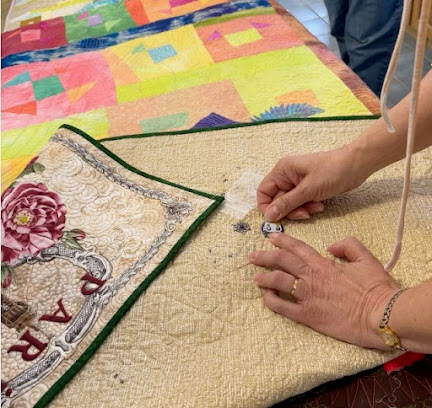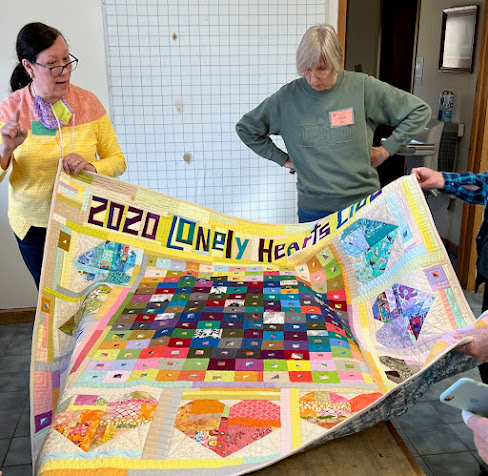 There was a hint of crisp, fall weather in the air, the colors of the landscape were turning to reds and golds against a clear "Carolina blue" sky. Like a picture postcard, the scene was beautifully composed for a long weekend of free-motion quilting at the John C. Campbell Folk School.
There was a hint of crisp, fall weather in the air, the colors of the landscape were turning to reds and golds against a clear "Carolina blue" sky. Like a picture postcard, the scene was beautifully composed for a long weekend of free-motion quilting at the John C. Campbell Folk School.Last weekend, I had a fabulous opportunity to teach an Intro to Free-motion Quilting workshop at the John C. Campbell Folk School. I had a group of inquisitive and motivated students, as well as a top-notch studio assistant (who was also my tour guide) and more than any instructor could ask for. The campus was magical, and the weather, perfect. All that to say, my first experience at the Folk School was wonderful and inspiring.
Arriving at the Folk School
Folk School instructors arrive early Friday afternoon for weekend classes. I met Geri, my fiber arts friend and studio assistant, at 2pm at the Keith House for registration. After dropping off my suitcase in my room at the Orchard House, Geri took me over to the Louise Pitman Fiber Arts building where the quilting and weaving studios are located.
 |
| Fiber Arts building at the John C. Campbell Folk School. |
The Quilting Studio has all the technologies!
The spacious quilting studio was technology-enabled with all the necessary “high” and “low” tech equipment—a large digital screen, iPhone camera for real-time filming, wi-fi, a white board, and a flip chart. Students had long tables to work on and flannel boards were mounted on the walls. A supply closet was filled with cutting tools, rulers, irons and other quilting equipment.
 |
| Inside the Quilting Studio at John C. Campbell Folk School. |
 |
| Drawing swirls and shell motifs. |
 |
| Discussing quilting strategies: where to start quilting, combining motifs, etc. |
A Bed-turning style Trunk Show
With the nice long tables in the studio, I opted for a bed-turning style process for showing and discussing a few of my quilts. The quilts illustrated various FMQ concepts—auditioning threads, determining thread weights and colors, adding texture with background fills, and using the patchwork to define areas to quilt.
.jpg) |
| A bed-turning style trunk show. |
 |
| How to audition threads for quilting. |
 |
| Free-motion designs inspired by the fabrics and the apppliqué. |
One of the quilts I included in the presentation was a fabric panel that was quilted and incorporated LED lights, a soft circuit with conductive thread, an Arduino computer chip, and a battery. This quilt was of particular interest to Geri, my studio assistant, as she was the person who sparked my interest in incorporating electronics and computer technology into quilts.
 |
| A small battery powers a soft circuit that is stitched into this quilt. Switches sewn to the quilt turn on/off the LED lights. |
I brought several quilts from Guild Challenges because these quilts always have interesting stories to accompany them. My most recent Challenge quilt, Alone Together, was from last year's Guild Challenge. For documentation on the process of this quilt, see this blog post about the design and patchwork process, this post for the quilting process and quilt stats, and my experiments and discoveries through working on this piece.
 |
| Discussing various aspects of Alone Together, a guild challenge quilt. |
Practice sandwiches
Students made several practice sandwiches for learning FMQ motifs and getting warmed up. We also used pre-printed placemat panels from Paintbrush Studio to try FMQ on a patchwork design (without having to deal with seam allowances).
Here are the FMQ stars from the workshop. Thanks to everyone for a great first-time experience at the Folk School! And a special Thank You to Geri for the in-class candid photos. I hope you all continue to grow in your quiltmaking journey and enjoy all the creative possibilities free-motion quilting has to offer.
 |
| October 21-23, 2022 Free-motion Quilting students at John C. Campbell Folk School. From left (back row): Wendy, Karen, Diane. From left (front row): Geri (studio assistant), Karen, Kathy, Kathie, Dina, Katy, Jackie and me (Veronica). Not pictured: Suzanne |
And this is the view in the morning from outside my dorm room. The Folk School can definitely change you!
 |
| View from Orchard House on an October morning. |



.jpg)





.jpg)